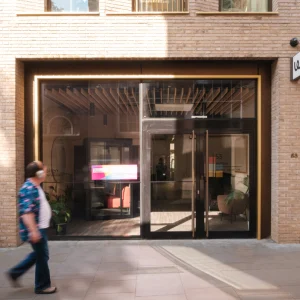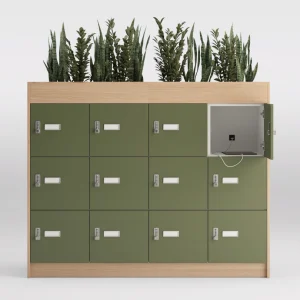November 2008 – Influential British artist Michael Craig-Martin has created two large scale artworks for the new building of the European Investment Bank (EIB), choosing as his medium the expressive versatility of DuPontCorian®. Located in the Kirchberg area of Luxembourg, the East building extension is linked to the EIBs existing headquarters, expanding the available workspace to 72,500 square metres. The elegant and innovative glass-shelled structure is designed to be subtle, functional, fully transparent and environmentally-friendly – so reflecting the priorities of the bank, which devotes a significant proportion of its lending to environmental projects aimed at combating global warming.
Renowned for his use of bright colours and images of everyday objects to elevate public spaces into works of art, Craig-Martin has produced two installations for EIB. These are an 88m long painting titled “Parade” for the staff cafeteria, and a sculptureset into the floor of the buildings main atrium titled “One World”. Both works exploit the exciting creative properties of Corian®, using inlaying and marquetry techniques, and a range of specially-developed vibrant colours, to create intricate line-drawings on an immense scale.
Far more than mere decoration, the designs are intended to be part of the fabric of the building, both transforming and becoming an integral part of the spaces they occupy. I try to conceive of works that do not appear to be simply added to the building, but rather ones that seek to become engaged or embedded- with the architecture in such an integral way that it becomes difficult to imagine the building without them says Craig-Martin.
Michael Craig-Martin has been a driving force in contemporary art for four decades and is considered to have been influential in the emergence of what has been called the Young British Artists Throughout his career, he has explored the expressive potential of commonplace objects and brought conceptual art to prestigious public spaces, and his latest work for the EIB reflects both of these themes.
Parade
Parade is an 88m-long by 4m-high installation that covers the wall joining the banks older west building (designed by Sir Denys Lasdun in 1980) to the new East building (designed by Ingenhoven Architekten), forming one side of the cafeteria space.
The largest work ever produced by Craig-Martin, Paradeis a compendium of more than 60 different images of everyday objects from a shoe to a piano, a football to a fire extinguisher. These overlapping images are drawn in 20 different bright colours of DuPont Corian® against a background of Corian® in Cameo White.
A number of materials were considered for the realisation of Parade and the decision to use Corian® came down partly to its seamless quality when joined – which enabled the images to continue along the full length of the fresco without interruption. The possibility of creating special colours in the material also appealed to Craig-Martin. However, he says: I did not believe at first that it would be possible to use modern marquetry to create a work on such an immense scale. The result is a tribute to the exceptional skills of Créa Diffusion, the French company specialised in the fabrication of Corian®.
The modern marquetry technique, used to fabricate Parade involved employing CNC machinery to carve out the outline of the images precisely, and then gluing thin strips of DuPont Corian® into the grooves. According to Thierry Delles, owner of Créa Diffusion, the sheer scale of the installation was the biggest challenge. Making each section required eight sheets of DuPont Corian® to be joined together onto a frame, and these panels each weighing 650kg – then had to be lifted by crane into the cafeteria building he explains.
Despite the challenges presented by the three month fabrication process, however, Delles adds: It has been fascinating to see what DuPont Corian® can achieve. This project perfectly demonstrates that it is a true material like wood or glass – and we are extremely proud to have played a part in creating this design
Designed to accompany staff during their off-duty moments, Parade features images of life outside the world of work and banking. It has no single point-of-view because there is no place from which it can be seen in its entirety. Instead, it is a work about movement, change and rhythm. Craig-Martin explains what he set out to achieve: I was very conscious of the fact that the people who will see this most often would be employees of the Bank, and that many of them would pass along this way several times every day. I wanted to make a work that was different along its entire length so that each time someone looks, there is the possibility that their eye may catch some image, some detail, some colour they have not noticed before
One World
The atrium of the EIB presented a particular challenge for Craig-Martin. On the one hand, he says, this dramatic central space – through which staff and visitors pass daily – asked for a sculpture but on the other, the floor space needed to remain open for functions and window cleaning.
The solution devised by Craig-Martin is a sculpture set into the floor, leaving the floor space completely free, and visible from every level and every location in the atrium. Although it is enormous and visually dominates this complex space, One World is a sculpture that takes up no room explains Craig-Martin.





